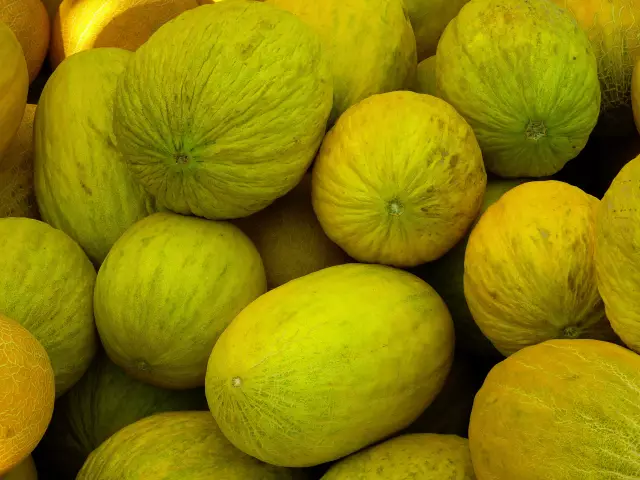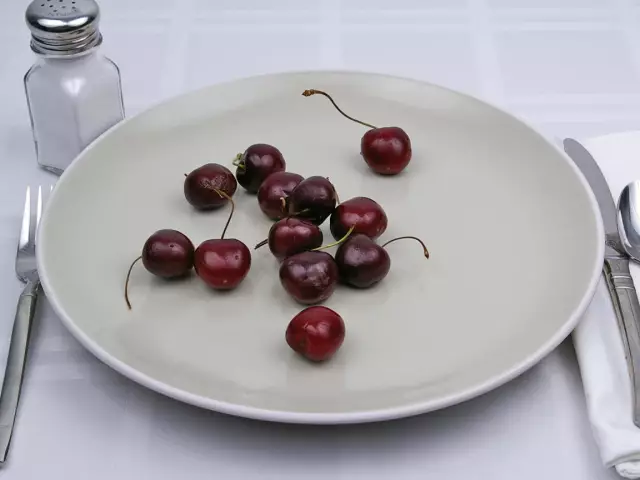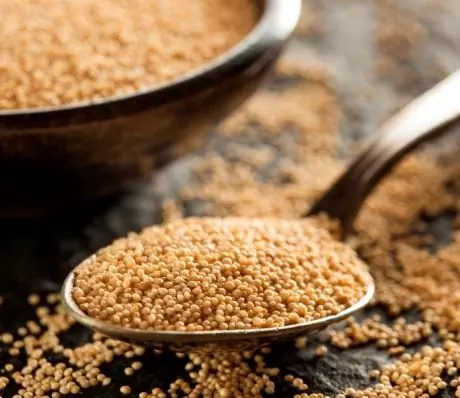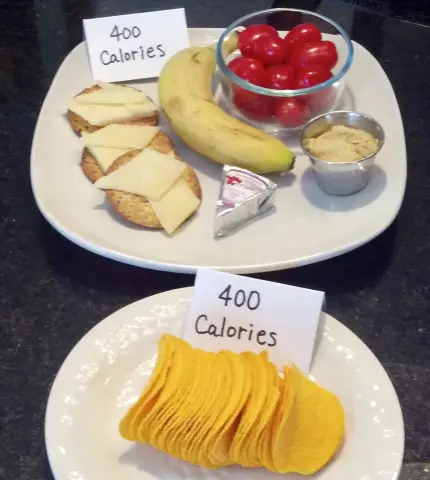- Author Rachel Wainwright [email protected].
- Public 2023-12-15 07:39.
- Last modified 2025-11-02 20:14.
Calorie melon

Melon is a plant that came from distant Central and Asia Minor, belonging to the Pumpkin family, a species of the genus Cucumber, and is a melon culture.
Melon fruits are edible fleshy fruits, which can also be considered culinary vegetables - they are round or oblong, reach 11 to 16.5 cm in diameter and weigh on average 450-850 g.
Outside, the fruit is covered with a dense skin, which can be of a flesh or orange-yellowish hue, the inside of the fruit is a light yellow, rather soft consistency, which has a juicy sweet taste and a musky aroma. In the center there is a small cavity filled with small white seeds, entangled with a cobweb of a mucous mesh, which, regardless of how many calories are in a melon, have a fairly high energy value.
Melon health benefits
Melon fruits are usually eaten chilled without the skin. The edible part of the fruit contains a lot of water (almost 95%) and, despite the low calorie content in the melon, is rich in vitamins A, B and C, contains protein, calcium, phosphorus and iron.
The fruit also contains a protein compound - collagen, the lack of which in the body leads to disruption of the integrity of the cellular structure of all connective tissues, and especially the skin. Collagen is able to accelerate wound healing and maintain skin elasticity.
Melon pulp, which is very limited in calories, contains carotenoids, which significantly reduce the risk of cancer, as well as the anticoagulant adenosine, which normalizes blood clotting, thereby reducing the risk of stroke and heart disease.
The high content of water and minerals in the fruit helps the digestion process and reduces acidity, while drinking melon with a little lemon juice helps with gout.
Also, melon, in which there are very few calories, acts as a diuretic in the body, which has a beneficial effect on the kidneys.
Calorie content of melon: nutritional and energy value of the fruit
The calorie content of melon allows you to use its fruits as a dietary product, since the body spends much more energy on the assimilation of the fruit than it receives from its use.
The nutritional value and calorie content of melon per 100 g of fruit is:
- Fat - 0 g;
- Cholesterol - 0 mg;
- Carbohydrates - 12 g;
- Proteins - 1 g;
- Dietary fiber - 1 g;
- Sodium - 23 mg;
- Vitamin A - 5,276 IU;
- The calorie content of a melon is 53 kcal;
- Folic acid - 33 mcg;
- Nicotinic acid - 1 mg;
- Vitamin B6 - <1 mg;
- Vitamin C - 57 mg;
- Calcium - 14 mg;
- Magnesium - 19 mg;
- Potassium - 417 mg;
- Carotenoids - 3219 mcg.
Melon calories: an easy weight loss diet
The low calorie content of melon allows this delicious fruit to be used in a variety of diets, as along with its beneficial properties and weight loss, it also helps cleanse the body of toxins and toxins.
The melon diet is excellent for the summer season, when not only melon is ripe, but also watermelon - the second main component of this weight loss complex. The diet lasts two weeks. Due to the low calorie content in watermelon and melon, during this time you can achieve excellent results and lose 3-4 kg. You will have to eliminate sweets, baked goods and fatty dairy products and switch to chicken, fish, fruits, vegetables and whole grains, you can also use olive oil, spices, salt, pepper and various herbs.
Every morning, right after waking up, you need to drink a glass of water mixed with half a sliced lemon.

The daily ration menu, calculated for two weeks, is as follows:
- Day 1: Breakfast - a cup of coffee, a slice of black whole grain bread and oatmeal. Afternoon snack - 100 g of low-calorie melon or watermelon. Lunch - vegetable soup, 150 g of boiled chicken breast and vegetable salad, poured with 1 tsp. olive oil. Snack - 100 g of cold melon or watermelon. Dinner - Greek salad;
- 2nd day: breakfast - a cup of coffee, a slice of black whole grain bread, 30 g of chicken shank. Afternoon snack - 100 g of cold melon or watermelon. Lunch - a portion of chicken broth, 150 g of boiled hake, 100 g of potato salad and a fresh tomato. Snack - 100 g of low-calorie melon or watermelon. Dinner - vegetable soup;
- 3rd day: breakfast - a cup of coffee, a slice of black whole-grain bread, spread with chicken liver pate. Afternoon snack - 100 g of cold melon or watermelon. Lunch - a plate of broth, 200 g of spaghetti and vegetable salad. Snack - 100 g of cold melon or watermelon. Dinner - 150 g risotto with vegetables;
- 4th day: breakfast - a cup of coffee, a slice of black whole grain bread, spread with butter and honey. Afternoon snack - 100 g of low-calorie melon or watermelon. Lunch - a plate of spinach, 200 g of boiled beef with vegetables and a salad of herbs. Snack - 100 g of cold melon or watermelon. Dinner - salad of 100 g of chicken, 50 g of boiled potatoes and 50 g of cauliflower, seasoned with 1 tsp. olive oil;
- Day 5: Breakfast - a glass of unsweetened lemonade, a slice of black whole grain bread and two chicken sausages with mustard. Afternoon snack - 100 g of low-calorie melon or watermelon. Lunch - 150 g of fried chicken, 100 g of boiled beans and a slice of black whole grain bread. Snack - 100 g of cold melon or watermelon. Dinner - Greek salad;
- 6th day: breakfast - a cup of coffee with milk, a slice of black whole grain bread and 50 g of ham. Afternoon snack - 100 g of cold melon or watermelon. Lunch - a plate of beef soup, 200 g of beef stew with vegetables and a salad of herbs. Snack - 100 g of low-calorie melon or watermelon. Dinner - 100 g of low-fat yogurt or kefir;
- Day 7: Breakfast - a glass of low-fat yogurt, a slice of black whole grain bread, 50 g of fresh cottage cheese and a slice of melon or watermelon. Afternoon snack - 100 g of cold melon or watermelon. Lunch - 200 g of sweet cabbage with beef and a slice of black whole grain bread. Snack - 100 g of low-calorie melon or watermelon. Dinner - vegetable salad.
The menu for the second week of this diet is fully consistent with the menu for the first week.
If there is no particular desire to observe such a long-term weight loss complex, then you can choose shorter versions of the melon diet. For example, you can use this fruit as a snack and dinner for a week. Even this type of diet will help cleanse the body and give good results in terms of weight loss.
Juicy, sweet and low in calories, cantaloupe is a great dessert that also helps break down fat.
The main thing to consider is that such a diet is only suitable for the end of the summer period - August and September are the months when the fruit ripens and you can be sure that the content of nitrates and chemicals added in the off-season for faster melon growth will be low in it.
Melon can also serve as a product for fasting days, because it contains a lot of fiber, due to which it well saturates the body with all the necessary vitamins and macroelements, and also maintains a feeling of fullness in the stomach for a long time and, despite how many calories are in the melon, on such days the pulp of the fruit can be consumed in unlimited quantities.
Found a mistake in the text? Select it and press Ctrl + Enter.






